Morphology of flowering plants – Part I
Table of Contents
The Root
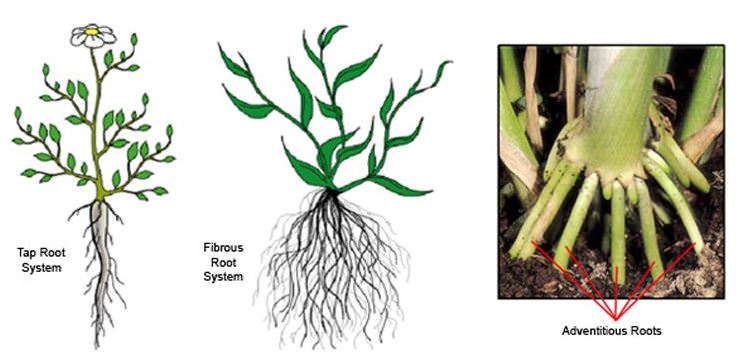
- Tap root: Primary root is formed by elongation of the radicle and it bears secondary and tertiary roots, present in dicot plants, e.g. gram, mustard, etc.
- Fibrous root: found in monocotyledons. A large number of roots originate at the base of the stem, e.g. rice, wheat, etc.
- Adventitious root: Primary root is not formed from the radicle, e.g. grass, banyan tree, maize, etc.
Modification of the Root
- For storage: taproots- carrot, turnip; adventitious roots- sweet potato
- For support: Prop roots of Banyan tree, that arise from branches; stilt root of maize and sugarcane, that comes out of lower stem nodes
- For aeration: pneumatophores present in mangroves help them in respiration as it grows in swampy areas. These roots grow upwards above the ground, e.g. Rhizophora
- For nitrogen fixation: root nodules of leguminous plants
The Stem
- Plumule develops into stem
- The part of the stem which bears leaves is called a node and the part between two nodes is known as the internode
Modification of the Stem
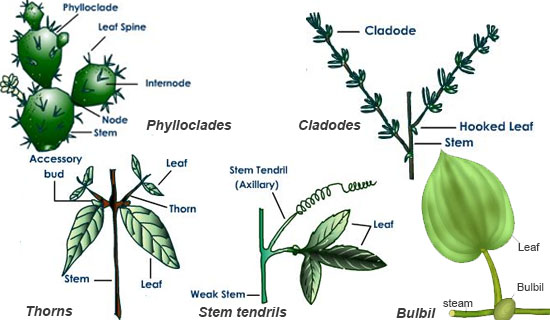
- Underground Stem: They help plants sustain unfavourable conditions for growth
- Rhizome- runs parallel to the ground and has nodes, internodes, buds, e.g. ginger, banana
- Tubers- the end part gets swollen as in potato
- Corm- it grows vertically below the ground, e.g. colocasia, etc.
- Bulb- stem is reduced and surrounded by scaly leaves, e.g. garlic, onions
- Stem Tendrils: these are a coiled structure that supports tender stem of the plant and help in climbing, e.g. grapes, cucumber, pumpkin
- Thorn: axillary bud gets modified into pointed thorns and protects plants from grazing animals, e.g. Bougainvillea, citrus
- Subaerial Weak Stem
- Offsets- internode of lateral branches decreases resulting in the rosette of leaves, e.g. Eichhornia, Pistia
- Suckers- lateral branches arise from the underground portion of the stem, e.g. chrysanthemum, banana, pineapple
- Runners- stem run horizontally above the ground and roots arise at nodes, e.g. grasses, strawberry
- Stolon- lateral branches arise normally but then bend down and touch the soil where the root grows and the new daughter plant arises, e.g. mint
- Aerial modification- The stem is completely metamorphosed for various adaptations, e.g. Phylloclade of xerophytic plants. The stem becomes fleshy and green having photosynthetic pigments to prepare food as leaves are reduced to thorns to check water loss by transpiration, e.g. Euphorbia, Opuntia
The Leaf
Leaves originate from the apical meristem of a shoot
Normally a leaf consists of three parts; leaf base, lamina and petiole
Leaf base attaches to stem and may have two small leaf-like structures known as stipule
Types of venation:
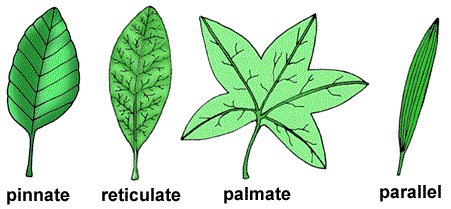
- Reticulate- present in dicotyledons, there is a network of veins present, which are irregularly distributed
- Parallel- present in monocotyledons, veins are parallel to each other
Types of Leaves:
- Simple- lamina is complete and incision doesn’t reach midrib
- Compound- incision touches midrib, that divides a leaf into a number of leaflets
- Pinnately compound- the leaflets are present on the common axis, i.e. midrib, called the rachis, e.g. Neem
- Palmately compound- leaflets are attached at the petiole tip, e.g. silk cotton
Phyllotaxy: pattern of arrangement of leaves around the stem
- Alternate phyllotaxy: In this phyllotaxy, a single leaf arises from the node of a branch. Examples are: Sunflower, mustard, and peepal, Hibiscus, Brassica
- Opposite phyllotaxy: Opposite phyllotaxy is when two leaves arise from the node of a branch and extend out in opposite directions. Examples are: guava and jamun tree, calotrophis
- Whorled phyllotaxy: Whorled phyllotaxy is when 3 or more leaves arise from the node of a branch. An example is alstonia.
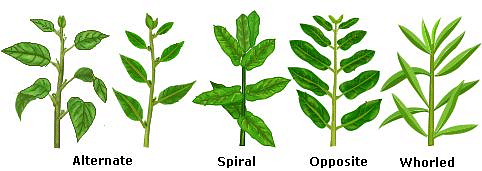
Modification of Leaves
- Tendrils- leaves modified to form a long thread-like structure, it gives support to climbers, e.g. peas
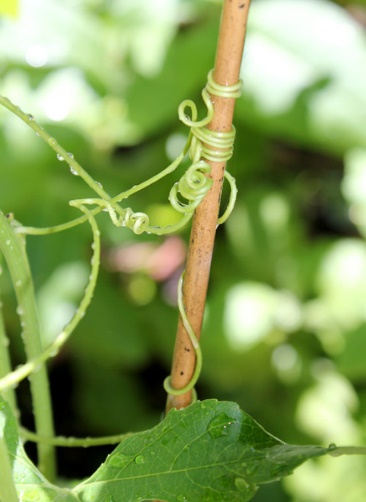
- Spine- in xerophytic plants to reduce water loss, e.g. cactus, aloe
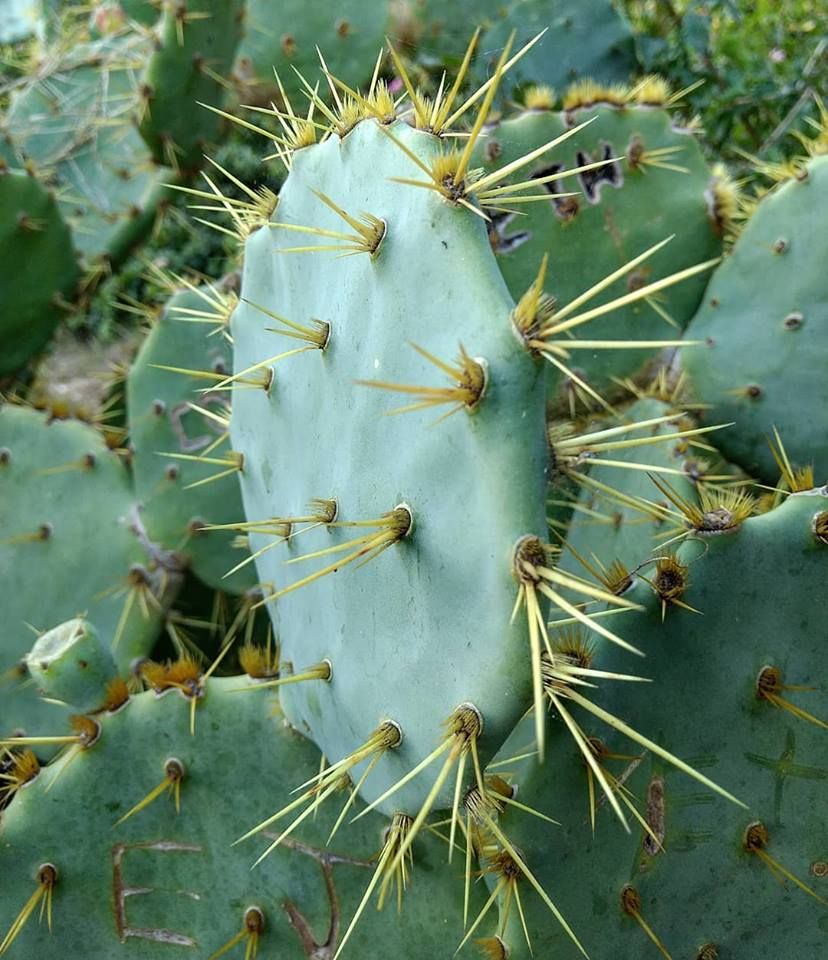
- For storage- e.g. garlic, onion
- Phyllodes- petiole gets modified to form a leaf-like structure and function, e.g. Acacia
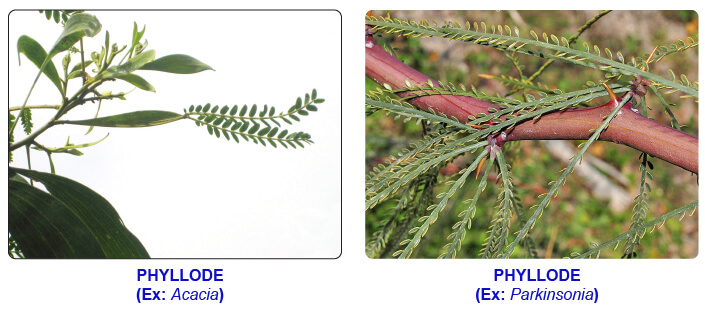
- Pitcher in pitcher plant is a modified leaf which traps insects inside
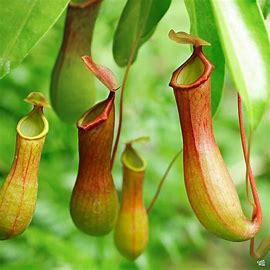
Inflorescence
- The arrangement of the flowers around the floral axis
- The two main types of inflorescence are
1. Racemose: the main axis grows indefinitely, flowers are present laterally in acropetal succession i.e. older flowers at the bottom and the younger ones at the top.
2. Cymose: the main axis terminates in flower and has limited growth. Flowers are borne in a basipetal order i.e. older flowers are at the top and new flowers are at the bottom.
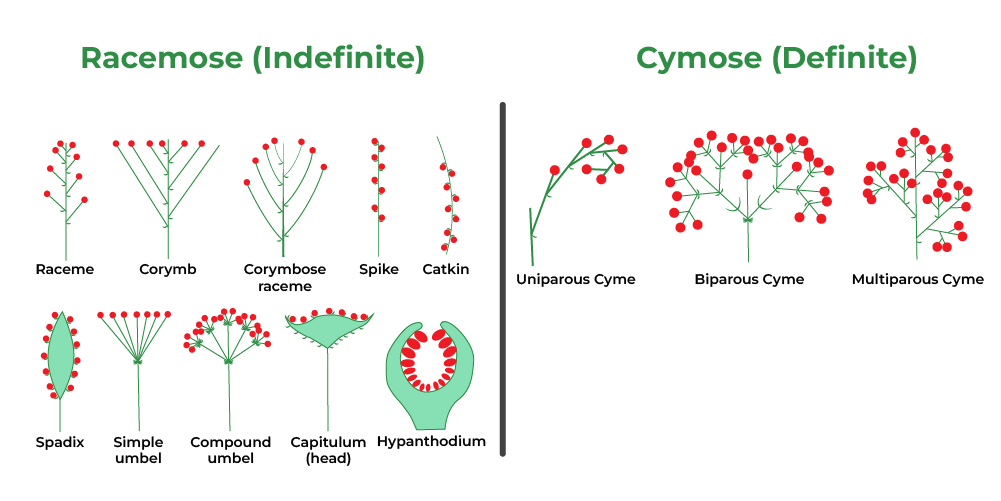
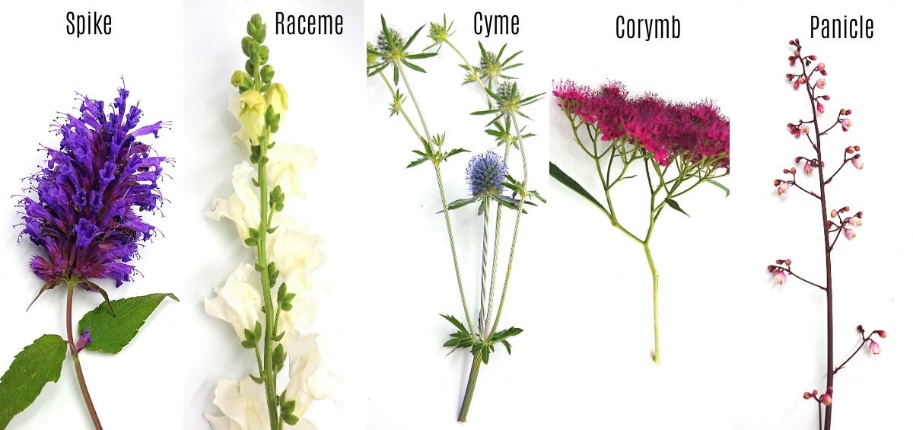
Special types of Inflorescence
3. Verticillaster: sessile flowers arranged in dichasial cyme, e.g. Ocimum, Salvia
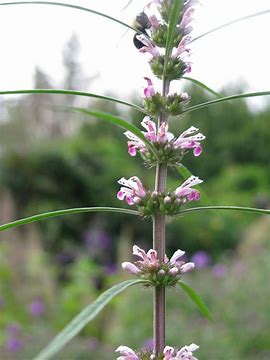
4. Cyathium: involucre of bracts form cup shape structure, single female flower is surrounded by numerous male flowers, e.g. Euphorbia
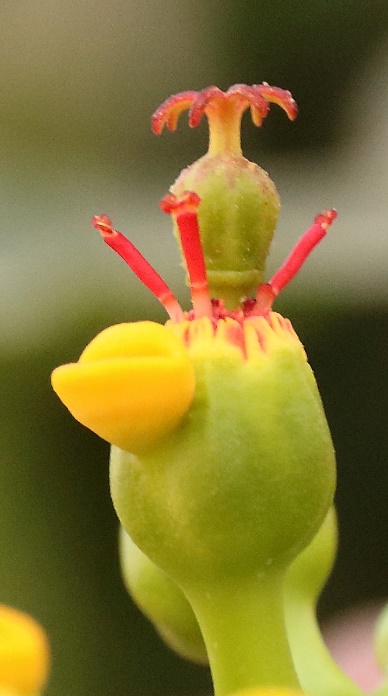
5. Hypenthodium: both male and female flowers are present in a cavity with an apical opening called ostiole
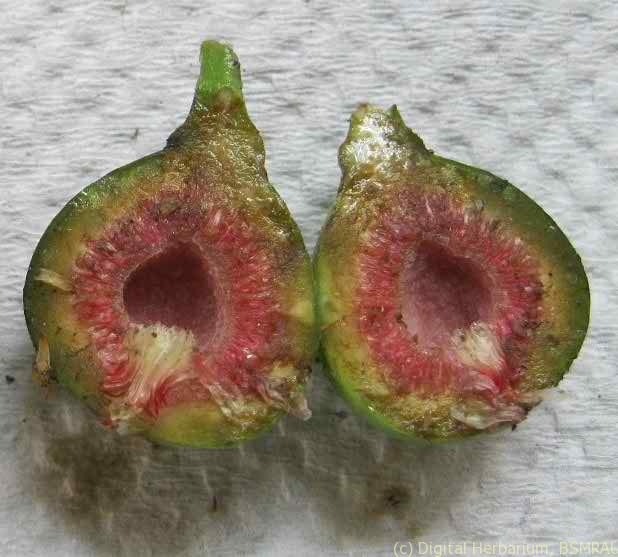
The Flower
- A flower has four whorls; calyx, corolla, androecium and gynoecium. These are attached to the swollen terminal of pedicel called the thalamus
- Flower symmetry:
1. Actinomorphic– radially symmetrical flowers, e.g. chilli, datura, mustard
2. Zygomorphic– when a flower can be divided into two equal parts in only one vertical plane, e.g. Cassia, pea, etc.
Flowers can be trimerous, tetramerous or pentamerous depending on the multiple of floral appendages present 3, 4 or 5
Types of flowers depending on the presence or absence of bracts (reduced leaf present at the base of pedicel); Bracteate or Ebracteate
Types of flowers based on the position of the ovary:
- Hypogynous- gynoecium occupies the highest place, above all the other parts. The ovary is known as superior, e.g. brinjal, china rose, mustard.
- Perigynous- gynoecium is present at the same level as the rest of the parts of a flower. The ovary is known as half inferior, e.g. peach, plum, rose.
- Epigynous- thalamus encloses the ovary completely and other parts are present above it. The ovary is known as inferior, e.g. ray florets of a sunflower, guava, cucumber
Calyx: A flower’s outermost whorl is made up of leaf-like structures called sepals
Gamosepalous- sepals united
Polysepalous- sepals free
Corolla: made up of bright coloured petals. Present after sepals
Gamopetalous- petals united
Polypetalous- petals free
[See more about flowers in Morphology of flowering plants part II library notes]
The Fruit
It is a matured and ripened ovary after fertilisation.
- Parthenocarpic fruit: the fruit formed without fertilisation, it makes seedless fruits, e.g. pineapple
- When the ovary wall ripens, it changes into a pericarp. Seed and pericarp make a fruit. The fleshy pericarp is made up of three layers; epicarp, mesocarp and endocarp
- Outermost Layer: Epicarp is the outermost layer of the fruits.
- Middle Layer: Mesocarp is the middle layer of the fruits.
- Innermost Layer: Endocarp is the innermost layer of the fruits.
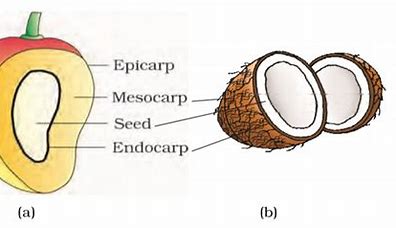
Simple Fruits
Simple Fruits are fruits that are developed from the monocarpellary ovary or multicarpellary syncarpous ovary. Thus, only one fruit is formed in the ovary. The fruit can either be fleshy or dry.
Fleshy Fruits:
- In fleshy fruits, the fruit wall is differentiated into three layers:
- Epicarp: The outermost layer.
- Mesocarp: The middle layer.
- Endocarp: The innermost layer.
- Examples of fleshy fruits include:
- Berry (e.g., grapes)
- Pepo (e.g., pumpkin)
- Hesperidium (e.g., orange)
- Drupe (e.g., plum)
Drupe: is a fleshy fruit that develops from either one or several fused carpels and contains one or many seeds. The seeds are enclosed by the hard protective endocarp (pericarp) of the fruit, e.g., mango. In mango the pericarp is well differentiated into an outer thin epicarp, a middle fleshy edible mesocarp and an inner stony hard endocarp.
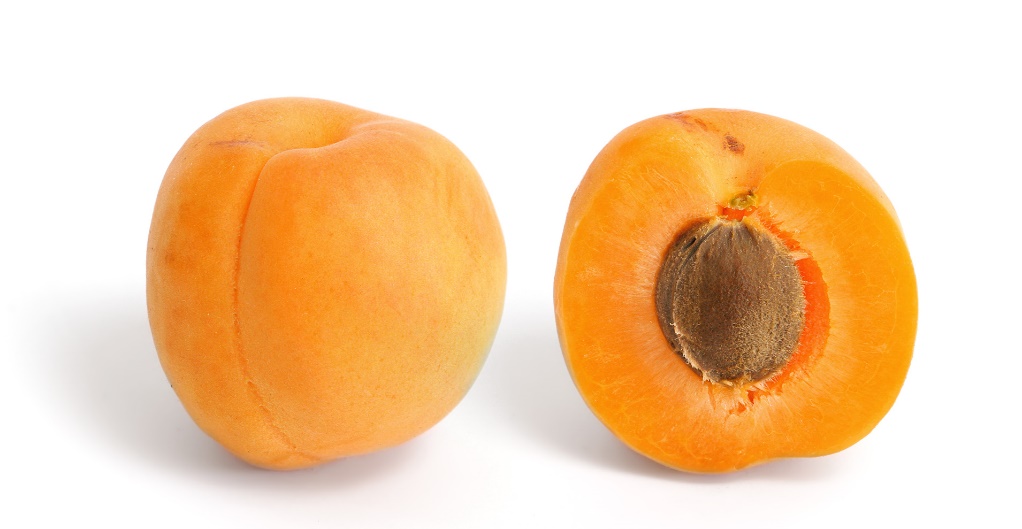
Eg. Apricot, Mango, plumPome (e.g., apple)
Apple and pear are pome. Pome is a false fruit in which the edible part is thalamus where the true fruit remains embedded.
Dry Fruits
- The pericarp (fruit wall) of simple dry fruits is usually quite dry and hard.
- The pericarp (fruit wall) of simple dry fruits is usually quite dry and hard.
- It is not differentiated into the three layers (epicarp, mesocarp, and endocarp).
- Some dry fruits dehisce (split open) to release seeds, while others remain indehiscent.
- Examples of dry fruits include:
- Dehiscent Fruits: Pericarp breaks down, and seeds are scattered (e.g., pea pods).
- Schizocarpic Fruits: Pericarp is arranged into one or more seeded segments (e.g., carrot).
- Indehiscent Fruits: Pericarp remains intact even after maturing (e.g., sunflower seeds).
Aggregate Fruits
When the fruits develop from the multi carpellary apocarpous ovary, they become fruitlets as each carpel is separated from the other. Different types of aggregate fruits include etaerio of follicles, etaerio of achenes, etaerio of berries, etaerio of drupes, etc.
- These fruits develop from a single flower with numerous pistils.
- Each pistil contributes to the aggregate fruit.
- Examples include:
- Raspberry: Formed from multiple tiny drupelets.
- Blackberry: Similar to raspberry but with a different arrangement of drupelets.
Composite Fruits
Composite Fruits consist of many ovaries and other floral parts which combine to form the fruit. It is a false fruit. They are of two types, namely, sorosis and sycosis.
- Pineapple is a sorosis type of fruit that develops from spike or spadix inflorescence. Here the flowers frise by their succulent tepals and axis bearing the flowers becomes fleshy or woody, thus forming a compact mass. These are composite or multiple fruits. In pineapple fleshy axis, bracts, fused perianth and pericarp are edible.
More on Fruits:
A fruit is a ripened ovary. On the basis of the formation of fruits, they are classified into two types – true fruits and false fruits. True fruits are developed from the ovary only.
Banana is a fleshy fruit – berry. It develops from multicarpellary syncarpous superior or inferior ovary. The pericarp of berries is differentiated into epicarp, mesocarp and endocarp (like drupes) but the endocarp is not stony as is drupes.
Pome is a false fruit in which the edible part is thalamus where the true fruit remains embedded. Fig is a composite fruit. These fruits are the products of the whole inflorescence together with its component parts. Apple and pear are pome.
- In litchi, aril forms the edible part in fruit. It is a collar like out growth from the base of the ovule forming a kind of third integument. Aril is also found in Asphodelus, Trianthema and Ulmus. Litchi is a nut. In litchi, the epicarp and mesocarp (layers of pericarp) together become leathery and the endocarp is membranous.
- The juicy hair-like structures in citrus fruits like lemon, commonly known as “pulp hairs,” develop from the endocarp, which is the innermost layer of the pericarp and surrounds the seeds.
The Seed
After the fertilisation, the ovule develops into a seed.
A seed has a seed coat and an embryo. An embryo is made up of radicle, embryonal axis and one or two cotyledons in monocotyledons (maize, wheat) and dicotyledons (pea, gram) respectively.
Structure of monocot seed:

The monocot seeds are mostly endospermic. The seed coat is thin and fuses with pericarp. It contains one cotyledon called scutellum and shoot axis. The lower part of the axis is the radicle, covered by a sheath called coleorhiza. The upper part of an axis is called plumule, covered by a sheath called coleoptile.
During the process of the development of the embryo, the food stored up in the endosperm is continuously drawn up by the developing embryo and thus completely exhausted. Such seeds are known as exalbuminous or non-endospermic. The common examples are : exalbuminous – gram, pea, bean, tamarind, orchid, etc.
Difference between dicot and monocot seed:
| Dicotyledonous seed | Monocotyledonous seed |
| The seed coat is made up of two layers; outer testa and inner tegmen There is a scar present through which the seed was attached to the fruit while developing, it is called the hilum The micropyle is a pore above the hilum | The seed coat is fused to the fruit wall and membranous |
| The embryo consists of an embryonal axis and two cotyledons | The embryo consists of one large cotyledon known as scutellum |
| Cotyledons store food | The endosperm is bulky and stores food |
| Mostly non-endospermic seeds. In castor, an endospermic seed is present- endosperm is formed due to double fertilisation and stores food | Mostly endospermic seeds. Some seeds like orchids are non-endospermic. Aleuron (a proteinaceous layer), is the outermost layer of endosperm, which separates the embryo |
| Radicle and plumule are present at the two ends of the embryonal axis | Plumule is enclosed in coleoptile and radicle is enclosed in coleorhiza |
Take Quiz
1. Which of the following stem gets modified into the flat and green organ to perform the functions of leaves?
a. Phylloclade
b. Cladodes
c. Scales
d. Phyllodes
ANSWER
a. Phylloclade
Explanation: Phylloclade is the flattened stem that performs the function of a leaf. It is the modified stem. Here, the leaves are modified into spines. Phylloclade becomes thick and fleshy succulent to perform the photosynthesis process. The primary function is to protect the plant from external injury.
2. The edible part of a coconut is known as
a. Pericarp
b. Perisperm
c. Endosperm
d. Cotyledon
ANSWER
c. Endosperm
Explanation: The edible part of the coconut is the seed. Seed or endosperm is white in mature coconut. This is cellular and opaque. Also, in green coconut water, the endosperm is nuclear. Mesoderm is the fibrous part, and endoderm is the hard or stony layer of the coconut.
3. Which of the following fruit is developed from condensed inflorescence?
a. Etaerio
b. Aggregate fruit
c. Composite fruit
d. Simple fruit
ANSWER
c. Composite fruit
Explanation: Composite fruit is the type of fruit developed from the condensed inflorescence. Both etaerio and aggregate fruits are formed from a single flower’s polycarpellary apocarpous gynoecium. Also, simple fruit is developed from the single ovary of a single flower. Sorosis type of composite fruit is developed from spikes, spades, or catkins inflorescences. Sycosis type of composite fruit is developed from hypanthium inflorescence.
4. Gynoecium with fused carpels is known as-
a. Syncarpous
b. Syngenecium
c. Apocarpous
d. All of the above
ANSWER
a. Syncarpous
Explanation: Gynoecium with fused carpels is known as syncarpous. The term is used for the flower with reference to the fused carpels or pistils in the gynoecium of that flower.
5. Identify the correct set of statements:
(a) The leaflets are modified into pointed hard thorns in Citrus and Bougainvillea
(b) Axillary buds form slender and spirally coiled tendrils in cucumber and pumpkin
(c) Stem is flattened and fleshy on Opuntia and modified to perform the function of leaves
(d) Rhizophora shows vertically upward growing roots that help to get oxygen for respiration
(e) Subaerially growing stems in grasses and strawberry help in vegetative propagation
NEET (UG) – 2022 QP
a. (b) and (c) only
b. (a) and (d) only
c. b), (c), (d) and (e) only
d. (a), (b), (d) and (e) only
ANSWER
c. b), (c), (d) and (e) only
- Thorns, which are woody, straight, and pointed structures, can also develop from axillary buds on stems. Many plants, including Citrus and Bougainvillea, have thorns.
- Stem tendrils, which are slender and spirally coiled, develop from axillary buds and assist plants in climbing. Examples of plants that use stem tendrils include cucumber, pumpkins, and watermelon.
- In arid regions, some plants modify their stems into flattened structures, such as Opuntia. These structures contain chlorophyll and carry out photosynthesis.
- Rhizophora grows in swampy areas, and many of its roots emerge from the ground and grow vertically upward. These roots, known as pneumatophores, aid in respiration by obtaining oxygen.
- Grass and strawberry underground stems spread to new environments, and new plants are formed through vegetative propagation when older parts die.
6. Which part of the fruit, labelled in the given figure makes it a false fruit?
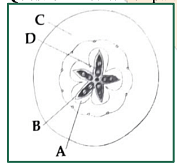
NEET (UG) – 2022 QP
a) A – Mesocarp
b) B-Endocarp
c) C-Thalamus
d) D-Seed
ANSWER
c. C-Thalamus
Solution and Explanation
Fruits are formed from the ovary of a flower after fertilisation. Such fruits are called true fruits. However, in a few species such as apple, strawberry, cashew, etc., some other parts of the flower, such as the thalamus also contribute to fruit formation. Such fruits are called false fruits. The diagram shown here is of an apple. The parts labeled as A is mesocarp, B is endocarp, C is thalamus, and D is seed.
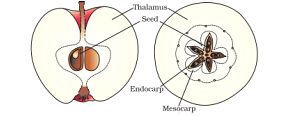
7. The roots that originate from the base of the stem are: (NEET 2020 QP)
a. Fibrous roots
b. Primary roots
c. Prop roots
d. Lateral roots
ANSWER
a. Fibrous roots
In most of the monocots, the roots that originate from the base of the stem are called fibrous roots.
8. Inflorescence is racemose in (NEET 2018 QP)
a. Tulip
b. Soyabeen
c. Aloe
d. Brinjal
ANSWER
b. Soyabeen
Racemose inflorescence is also called indefinite and indeterminate type. Growth of the peduncle is indefinite. Here the terminal bud will not modify into a flower. Flowers develop in acropetal succession i.e., mature flowers are towards the base and the younger ones towards the tip of the peduncle. Flowers open in centripetal succession i.e., opening of flowers proceeds from the periphery to the centre of the inflorescence. Peduncle may be unbranched or branched. Soybean belongs to family Fabaceae which has racemose inflorescence.
9. Which one of the following plants shows vexillary aestivation and diadelphous stamens? (NEET 2022 QP)
a. Colchicum autumnale
b. Pisum sativum
c. Allium cepa
d. Solanum nigrum
ANSWER
b. Pisum sativum
Pisum, which is also known as pea, exhibits vexillary aestivation and has stamens that are diadelphous. On the other hand, Colchicum autumnale, Solanum nigrum, and Allium cepa exhibit valvate aestivation.
10. Long filamentous threads protruding at the end of a young cob of maize are:
a. anthers
b. Style
c. Ovaries
d. hair
ANSWER
b. Style
In maize, the styles are the long, thread-like structures that extend from the top of each kernel or ovule. They are part of the female reproductive structure and play a role in pollen capture and fertilization.
